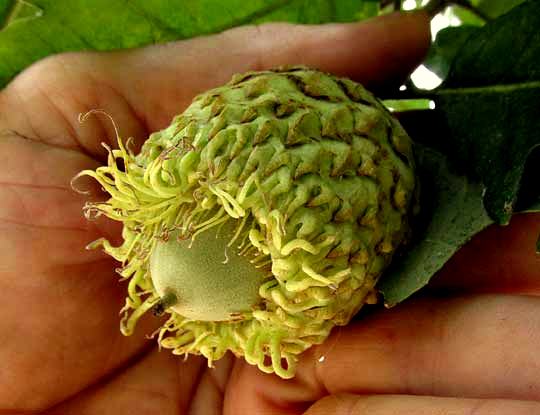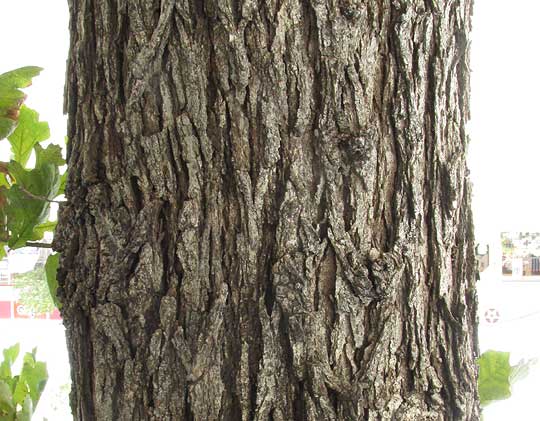Excerpts from Jim Conrad's
Naturalist Newsletter

from the October 5, 2014 Newsletter issued from the Frio Canyon Nature Education Center in the valley of the Dry Frio River in northern Uvalde County, southwestern Texas, on the southern border of the Edwards Plateau; elevation ~1750m (~5750 ft); N29.62°, W99.86°; USA
BURR OAK
One of the most distinctive, robust and best known of all oaks, one with characteristically deeply lobed leaves and enormous acorns with fringed, scaled cups, is shown above. That's the Burr Oak, QUERCUS MACROCARPA, the "macrocarpa" in the binomial meaning "big fruit." And that acorn-type fruit really is large, as shown by the immature one in my hand, below:

Burr Oak acorns are the largest of all oak species -- with cups up to 2-3/8ths inch across (60 mm). The species is distributed from southern Canada to southern Texas, with acorns generally diminishing in size the farther north they grow, so some of the largest are likely to be found in this area. Burr Oaks are missing in western North America and most of the US Southeast, but extend eastward to Kentucky and New England.
Back in Kentucky where I grew up I was surprised to find Burr Oaks both in frequently flooded swamps around our farm and in thin, dry soil on limestone hills, but seldom in in-between habitats. I always figured that eventually taxonomists would recognize the presence of two look-alike Burr Oak species. However, though the online Flora of North America also mentions that in the northwestern part of the species' range Burr Oaks produce shrub forms on bluffs and hillsides, and that future study may find that such forms are different from tree-sized Burr Oaks, at this time, still, the general consensus is that all these variations are just different expressions of one variable species.
Though Burr Oaks do occur naturally in south-central Texas -- natural populations occur just a couple of counties east of here -- in Uvalde County here in the southwestern corner of the state, we're a bit beyond the species' natural distribution. Apparently it's too dry here for Burr Oaks. The tree in our photograph grew along a sidewalk in the town of Uvalde, having been planted there. In fact, Burr Oaks are seen as such desirable trees to plant that distinct cultivars have been produced through selective breeding, such as the 'Lippert,' the 'Boomer' and the 'Ekalaka Germplasm bur oak.'
One reason Burr Oak is so appreciated by many people is that its wood is one of the best of all oak species, similar to that of White Oak. Another admirable feature is that it provides food for deer, turkeys, squirrels, rabbits, raccoons, rodents and many other forms of wildlife, plus at maturity it makes a fine roosting, loafing, and nesting site for birds. Because Burr Oaks grow so tall -- up to 130 feet (40 m) -- and are so strong and fire resistant, they're preferred for planting as windbreaks.
Indigenous North Americans traditionally used Burr Oak medicinally to treat heart troubles, cramps, diarrhea, broken bones, to expel pinworms, and as an astringent (puckerer).
Our Burr Oak's dark gray, flat-ridged trunk is shown below:
